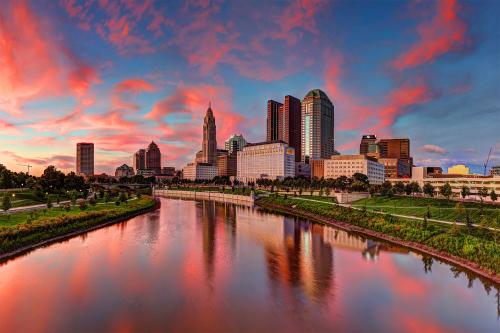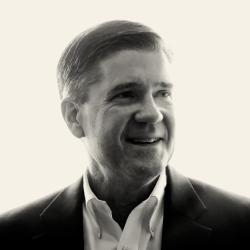“Here we are proud of our industrial history; we are the hard workers that drove our nation’s economy forward after World War II.”
Those words could have been spoken by someone in my home state of Michigan, from a city like Flint or Detroit. Instead, I was hearing from the local manager of a new startup and innovation hub deep in the Ruhrgebiet, the German coal and steel region that once housed the nation’s heavy industry, twin to our nation’s Rust Belt.
The manager spoke to a group of international leaders participating in a Public Diplomacy Visitors program sponsored by the German government. We traveled to the Rurhgebiet to examine Germany’s approach to facilitating structural economic change, a topic of particular interest to our own industrial Midwest
I was struck by two realities: The economies and cultures of our industrial regions are quite similar; but our countries’ approaches to dealing with dynamics of economic dislocation and transition are radically different. Our newfound interest in revitalizing U.S. economic regions currently being “left behind” could benefit greatly from Germany’s longstanding experience.
Strong leadership from the center
There is increasing concern in the United States about growing regional economic disparities, especially between our large, coastal, and university cities pulling away economically and socially/culturally from smaller former industrial cities and rural communities. In contrast to the U.S. government, however, the German government actually makes significant efforts to address its similar regional divides.
Those efforts emanate from a more politically aggressive commitment to “balance” growth in the German Constitution, which explicitly sets a goal of ensuring equal living conditions and quality of life for the nation’s residents, wherever they live. This has set up a durable, above-politics, non-partisan consensus that government should purposefully do what it can to aid adjustment in regions undergoing economic disruption and change. One result is that conservative German politicians and their constituents in the country’s rural and formerly industrial regions remain supportive of federal and even EU wide-economic adjustment policies and programs. As one example, Germany is working to update its social insurance system and celebrated occupational training programs to better support adaptation for a fast-changing workplace, including lifelong retraining and re-credentialing.
The U.S. federal government has no such shared consensus to aid residents of regions struggling with economic change. The conservative Republicans that voters in many of our former industrial regions have sent to Congress and the White House have fanned resentment over efforts ranging from expanded health care insurance, to social welfare supports, to investments in clean energy and economic development, despite the fact that their communities arguably have the greatest need for extra government stimulus. Political changes stateside could, however, help establish a greater role for our central government in facilitating successful industrial transitions.
Attending to the past while preparing for the future
We saw in specific Ruhrgebiet communities examples of strategies for managing structural change that aim to bridge a successful past, through an uncertain present, toward a more hopeful economic future. Their broad approaches are applicable to our own efforts in the United States to rebalance economic growth and narrow yawning regional income and opportunity divides:
- Ease the painful decline of once dominant sectors. We were on hand when the last coal mine of the Ruhrgebiet ceased active operations, ending a 25-year planned phase-out of coal and steel mines that once defined the region. The German government supported the transition with generous financial aid, retraining, and relocation assistance for displaced workers to find niches in new, growing industries and communities.
- Build on historical and cultural legacies. We toured the Zollverein Coal Mine Industrial Complex in Essen, one of the iconic coal and steel facilities that more than a century ago revolutionized these industries. Zollverein today is a UNESCO world Heritage site, museum, conference area, and start-up incubator for technology firms playing to the region’s historical strengths and numerous small and medium-sized enterprises (SMEs) to provide new data and business-to-business solutions.
- Leverage research and learning institutions. We visited the Fraunhofer Society, a network of 72 public/private-funded applied research institutes sprinkled across Germany that aid the country’s dense network of SMEs in developing cutting-edge processes and products. Several newer Fraunhofer institutes, like Duisburg’s dedicated to microelectronics, were created in former industrial regions beginning 25 years ago as part of a deliberate effort to establish new centers of talent, R&D, and innovation support.
- Lean in to the “green” revolution. We visited with leaders in former mining and steel communities like Bottrop that are organizing around a goal of reducing carbon emissions by 50 percent in 10 years as a prototype for other “innovation cities” in Europe. They are testing a model of how to support sustainable business growth, technology deployment, and build a community with rich quality of life and place.
- Connect to the digital economy. The German federal government is pushing the extension of 4G mobile network coverage and high-speed internet access to small towns and rural regions so firms, entrepreneurs, families, and learning/research institutions can be full participants in today’s economy. Those investments are critical to facilitating communities’ participation in a program called Industry 4.0, which enables them to build machine learning systems to manage data exchange, networks, inventories, and communications in the internet of things, up and down the supply and production chains.
These forward-thinking initiatives stand in stark contrast to the rhetoric of the current U.S. administration, which promises economic restoration of the Heartland by propping up legacy industries that have little chance at delivering sustainable growth and higher living standards.
Ideas worth importing and adapting
The Germans are certainly planners, and some of these efforts do have a top-down, heavy-handed quality, despite good rhetoric about community participation and inclusion. And I would not want to trade nor kill off the chaotic, entrepreneurial, and hypercompetitive character of our uniquely American and Midwest innovation landscape. In the U.S., no one plans the next disruptive technology; an innovative spark grows spontaneously from our network of public-private research and market-oriented technology (often immigrant) entrepreneurs.
However, a country that commits to do what it can to balance growth, and close wide geographic and personal opportunity divides, can nurture a more equitable economy and a less polarized polity.
In America’s proud industrial heartland we need leadership willing to name and make real progress on the fundamental infrastructure that underpins economic adaptation and growth. We must enhance connectivity, build out from our own leading research and learning institutions, help workers adapt to change, leverage our storied history and culture, and embrace the sustainability revolution for economic benefit.
As the Germans have learned, there’s an important role for both government policy and community initiative in achieving broad-based economic prosperity.
An edited version of this blog has also been published by the Chicago Council on Global Affairs where John Austin is a nonresident senior fellow, global Midwest.
The Brookings Institution is committed to quality, independence, and impact.
We are supported by a diverse array of funders. In line with our values and policies, each Brookings publication represents the sole views of its author(s).







Commentary
A tale of two Rust Belts: German models for post-industrial prosperity provide lessons for the US
October 22, 2018